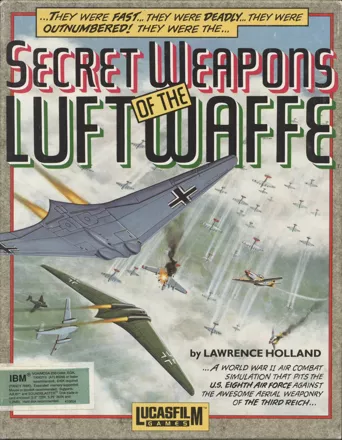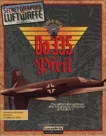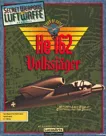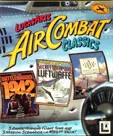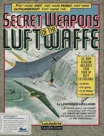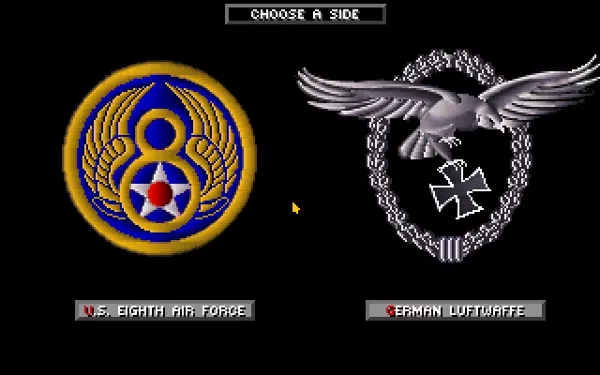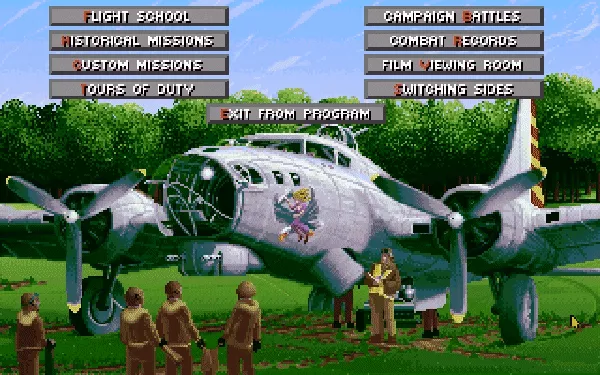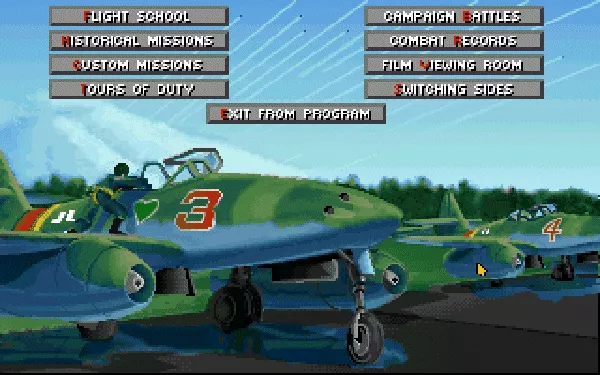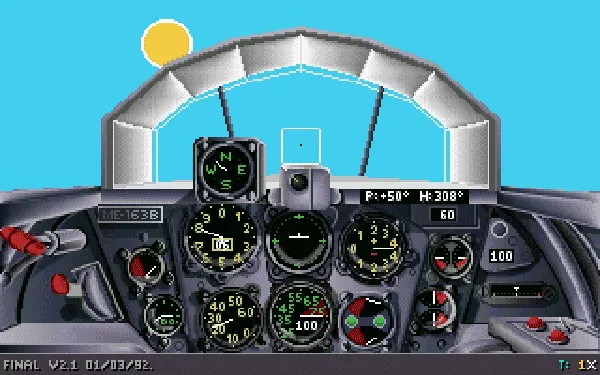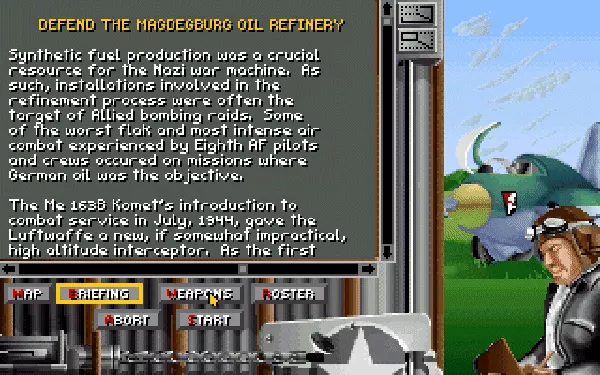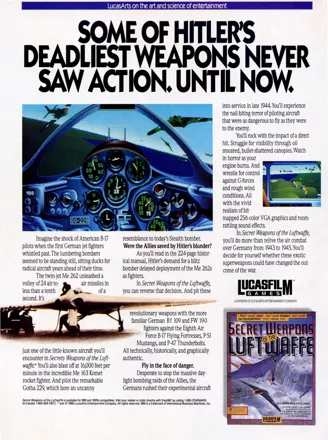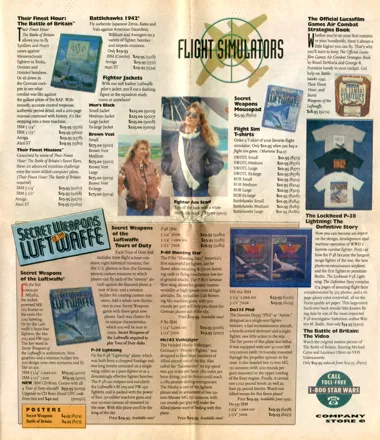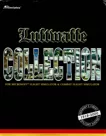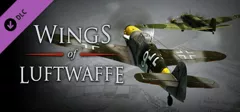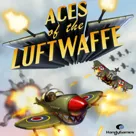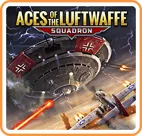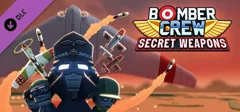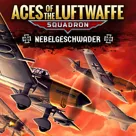Secret Weapons of the Luftwaffe
Description official descriptions
Fly as an American or German pilot in the years 1943-1945 in this WWII air combat simulation. This game features several experimental German aircraft to try out. Can you alter the outcome of WWII with them? The experimental German planes include Messerschmitt 262, Me163 Komet rocket plane, and the Gotha "flying wing". You can also fly the traditional ME109 or FW190 piston engine aircraft.
As for the American side, you can take to the skies in the P-51 Mustang, P-47 Thunderbolt, or the B-17 Flying Fortress bomber. In the B-17, you can not only control the plane itself, but also the gun turrets and the bombing sight.
Next to training missions for each aircraft, there are several historical missions available, recreating real air encounters of the war.
The Tour of Duty mode allows you to take your pilot through a set number of missions, gaining promotions and medals, with the ultimate goal of surviving the tour.
Finally, there's the strategic campaign mode where you can fight the whole war from either side, both planning and flying missions. As the Americans, the objective is to cripple Germany's industry through strategic bombardment. As the Germans, you have to survive by keeping the industry alive. As time passes, new aircraft become available, in accordance with history. For instance, the Mustang was not deployed until late 1943. For the German side, the jet and rocket aircraft have to be researched before they can be built. The German side can also build V1 and V2 missiles. Another option is to let industrial branches work in secret to hinder the American bombing efforts.
Other interesting features are a mission editor and a film playback option.
Spellings
- 納粹飛行祕史 - Traditional Chinese spelling
Groups +
- Aircraft: Boeing B-17 Flying Fortress
- Aircraft: Focke-Wulf Fw 190
- Aircraft: Horten Ho 229
- Aircraft: Messerschmitt Bf 109
- Aircraft: Messerschmitt Me 163
- Aircraft: Messerschmitt Me 262
- Aircraft: North American P-51 Mustang
- Aircraft: Republic P-47 Thunderbolt
- Gameplay feature: Recordable replays
- Games with code-wheel copy protection
- LucasArts Classic / Collectors Series / Collection releases
- Lucasfilm WWII Air Combat trilogy
- Secret Weapons series
- Top Shots / Topshots releases
Screenshots
Promos
Credits (DOS version)
65 People (63 developers, 2 thanks) · View all
| Project Leader | |
| Lead Programming | |
| Graphics / Artwork | |
| Music | |
| Lucasfilm Games V.P. and General Manager | |
| Documentation | |
| Producer | |
| Managing Director | |
| Director of Operations | |
| Associate Director of Marketing | |
| PR Manager | |
| Marketing Manager | |
| [ full credits ] | |
Reviews
Critics
Average score: 86% (based on 11 ratings)
Players
Average score: 3.6 out of 5 (based on 27 ratings with 3 reviews)
The ultimate WWII air combat simulator
The Good
Where to begin? It had incredible graphics (for its time), all those wickedly awesome German experimental planes (I LOVE the Komet!), and even more historical information! Even though WWII air combat games have been made since SWOTL came out that featured fancy 3D graphics and speech and other stuff, this game still is rules. No other game has represented the variety of experimental WWII planes that SWOTL does like the DO 335, Me163, He 162, and P80.
The campaigns were fun too! It was challenging to try to keep your levels above minimum (if you were playing the Germans), or to somehow bomb the 3rd Reich into the stone age. I usually used my trusty P-47 and just blasted buildings with those 8 Colt-Browning .50 cal machine guns rather than the B-17. ;)
The attention to detail was awesome. From the speed brakes on the P80 to the oil on the windshield to the accurate representation of weapons like the Jagdfaust, this game just blew me away.
The Bad
I guess this is similar to my BattleHawk's 1942 complaint... I wish the game could have featured more planes in the air, even more types of planes (the Germans were working on some really wild stuff in the final months of the war), and one thing that several other people have told me they wanted to see: Italian and Russian planes. And where were the English planes?? All they needed to do was make a few updates to the old BOB:TFH RAF planes and add 'em. :) What about other types of US bombers like the B-24 and 26?
I realize that at the time it came out that would have made the program really big and probably not many people could have run it with the computers back then, but if they had continued to release new planes I'm sure they'd still be bought. I know I would have updated! :)
The Bottom Line
If you ever have a chance to play or buy this game, do it. You will love it.
DOS · by Raphael (1245) · 1999
Eclipsed by other flight sims of its day, SWOTL remains fun and accessible.
The Good
The premise of the game was intriguing. What if the Germans had fully developed the horde of experimental aircraft that they were working on during the course of WWII? Would the outcome of WW2 have changed? Could the sheer number of Allied aircraft, and in particular Allied bombers, still have smashed the Reich?
As with LucasArts other WW2 flight simulations, the design of SWOTL made the game instantly accessible and engaging. I don’t believe any other game since has allowed a player to so readily jump into so many powerful, dangerous, and bizarre aircraft. If you wanted instant action, you could have it. If you wanted to play a dynamic campaign using any of these dangerous aircraft, that was available. I remember buying IL2: Forgotten Battles – Aces Expansion Pack, believing that it would allow me to again fly some of these great aircraft in campaigns against waves of Allied bombers. However I was to be disappointed; the Aces Expansion Pack just didn’t have the range of aircraft, the ready made dynamic campaigns, and instant action of SWOTL.
Players have the opportunity to use a number of powerful, dangerous, and bizarre aircraft. My own personal favourite was the Me-163 Komet rocket plane. Loaded with rockets, it would gain altitude and streak towards bomber formations at a terrifying speed. With its limited fuel load, the only way to get home safely was to glide back with no engine power. Although hard to hit, the Komet could take very little damage, as it was prone to explosions. The landings were harrowing as the landing gear was not comprised of a wheel assemblage, but rather a single skid – the pilot had to literally slide his aircraft across the field as if he were tobogganing. What a thrill! However, other monstrosities such as the Gotha Flying Wing and the famous Me-262 also had their charms. I found that, true to life, The Me-162 jet fighter was one to stay away from. History tells us that the 162 was derisively referred to as “The Cheap And Nasty” by German fighter pilots, because it was built to be light and inexpensive - almost disposable - and its in-game performance accurately reflects this.
The stability of the game was rock solid; I recall no issues at all with bugs, lock-ups, or crashes. Since I love replaying older games, I’ve used SWOTL on a number of different machines. However, given that the game engine was several years old, stability was to be expected.
The Bad
When speaking about the problems with SWOTL, one has to look at the history of LucasArts flight simulations. With the release of Battlehawks: 1942 and Their Finest Hour in 1988 and 1989 respectively, LucasArts redefined WWII flight simulations and set the stage for all future games in this genre. Battlehawks and Their Finest Hour were the first games that truly made it feel as if you were flying in history’s greatest battles. Much of the reason for this was the sprite based graphics engine. I still remember how astonished I was at how accurately the Messerschmitt fighters and Dornier bombers were drawn. You could actually pick out the red nosed fighter that German ace Molder flew in battle. Firing at a big Heinkel at close range, you could see pieces flying off; if you were low enough over the Channel, you could see (and hear) pieces hit the water. How satisfying it was to see those damaged bombers drop their eggs early and attempt to turn for home, only to be raked wingtip to wingtip by my gunfire! I remain convinced that, at the time these games came out, polygon graphics could not possibly have included this much detail in the aircraft LucasArts modelled.
Then in 1990 Dynamix released Red Baron. Here was a game that used a huge number of smoothly rotating polygons rather than sharply jumping sprites. So much detail was put into the vehicles that even their control surfaces moved. For the first time, a virtual cockpit was possible, with seemingly unlimited angles of view. Clearly flight simulation had advanced enormously in a very brief time period. Being a huge fan of Their Finest Hour in particular, I still waited eagerly for SWOTL’s release, anticipating great advances in its game engine as well. However when it was released in 1991, it was obvious that SWOTL had been eclipsed. LucasArts had still used the same sprite based engine that Battlehawks:1942 had used three years earlier. After seeing the new polygon graphics of Red Baron, watching SWOTL’s aircraft jump between perpendicular and 45 degree angles was painful. Simply put, LucasArts had stuck with the same engine for one game too long. One can note that with the release of X-Wing in 1993, LucasArts too had moved on to polygon graphics, and with great success.
SWOTL’s dated game engine extended to other areas well. Sound had made no great advances. Explosions, gunfire, and even wind effects are all very similar if not exactly the same as in previous offerings. The flight model had made no great advances. When playing Red Baron, one could tell that an aircraft was close to stalling by its sluggish responses, whereas such subtle cues were not as evident in SWOTL.
The Bottom Line
LucasArts’ WW2 flight simulations reigned supreme in the late 80s. However, they stuck with an old game engine too long, and SWOTL was outclassed by its peers. Nevertheless, it remains a fun diversion because of its strong premise, dynamic campaign, and underlying game design emphasizing instant action and playability.
DOS · by Les Nessman (265) · 2005
Awesome variety of aircraft and missions
The Good
Lots of different aircraft and missions. Wonderfully imaginative. The individual aircraft sounds were a treat and were pleasingly exotic for the advanced German aircraft. Mission recorder was a nice touch. The game's open architecture was a wonderful training ground for budding game hackers. :-)
On a side note, LucasFilm Games had an 800 number you could call for SWOTL game hints. I called the number once to hear a recording of what sounded like a kindly grandmother offering pointers on air combat tactics. :-D
The Bad
3D renderings were a little subpar even for a game released in 1991. The B-17 missions were overly simplified.
The Bottom Line
Wonderful variety, loads of fun.
DOS · by Dasharatha (8) · 2009
Trivia
Add-ons
Four extra aircraft were released as separate add-ons: the P-38 Lightning and P-80 Shooting Star for the USAAF and the He 162 Volksjäger and Do 335 Pfeil for the Luftwaffe.
Cancelled versions
Also advertised for the Amiga and Atari ST as due in 1991.
Awards
- GameStar (Germany)
- Issue 12/1999 - #72 in the "100 Most Important PC Games of the Nineties" ranking
- PC Games (Germany)
- Issue 01/1993– #2 Best Simulation in 1992
Information also contributed by mike forster
Analytics
Identifiers +
Contribute
Are you familiar with this game? Help document and preserve this entry in video game history! If your contribution is approved, you will earn points and be credited as a contributor.
Contributors to this Entry
Game added by Raphael.
Additional contributors: phlux, Rambutaan, Martin Smith, Paulus18950, Patrick Bregger.
Game added August 20, 1999. Last modified February 4, 2024.


